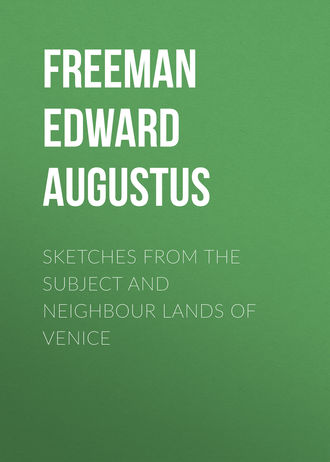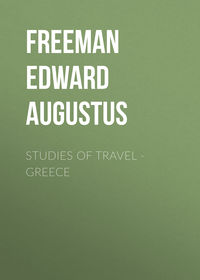 полная версия
полная версияSketches from the Subject and Neighbour Lands of Venice
We are again driven to ask, Which is the dialect of the Romans? What word either of Greek or of Latin can the Emperor have got hold of? At the same time he had got a fair notion of the general position of Cattaro, though he runs off into bits of exaggeration which remind us of Giraldus' description of Llanthony. The city stands at the end of an inlet of the sea fifteen or twenty miles long, and it has mountains around it so high that it is only in fair summer weather that the sun can be seen; in winter Dekatera never enjoys his presence. There certainly is no place where it is harder to believe that the smooth waters of the narrow, lake-like inlet, with mountains on each side which it seems as if one could put out one's hand and touch, are really part of the same sea which dashes against the rocks of Ragusa. They end in a meadow-like coast which makes one think of Bourget or Trasimenus rather than of Hadria. The Dalmatian voyage is well ended by the sail along the Bocche, the loveliest piece of inland sea which can be conceived, and whose shores are as rich in curious bits of political history as they are in scenes of surpassing natural beauty. The general history of the district consists in the usual tossing to and fro between the various powers which have at different times been strong in the neighbourhood. Cattaro – τὰ κάτω Δεκάτερα – was in the reign of Basil the Macedonian besieged and taken by Saracens, who presently went on unsuccessfully to besiege Ragusa. And, as under Byzantine rule it was taken by Saracens, so under Venetian rule it was more than once besieged by Turks. In the intermediate stages we get the usual alternations of independence and of subjection to all the neighbouring powers in turn, till in 1419 Cattaro finally became Venetian. At the fall of the Republic it became part of the Austrian share of the spoil. When the spoilers quarrelled, it fell to France. When England, Russia, and Montenegro were allies, the city joined the land of which it naturally forms the head, and Cattaro became the Montenegrin haven and capital. When France was no longer dangerous, and the powers of Europe came together to part out other men's goods, Austria calmly asked for Cattaro back again, and easily got it. To this day the land keeps many signs of the endless changes which it has undergone. We enter the mouth of the gulf, where, eighty years ago, the land was Ragusan on the left hand and Venetian on the right. But Ragusa and Venice between them did not occupy the whole shore of the Bocche; neither at this day does the whole of it belong to that Dalmatian kingdom which has taken the place of both the old republics. We soon reach the further of the two points where Ragusan jealousy preferred an infidel to a Christian neighbour. At Sutorina the Turkish territory nominally comes down to the sea; nominally we say, for if the soil belongs to the Sultan, the road, the most important thing upon it, belongs to the Dalmatian King. And if the Turk comes down to the Bocche at this end, at the other end the Montenegrin, if he does not come down to the water, at least looks down upon it. In this furthest corner of Dalmatia political elements, old and new, come in which do not show themselves at Zara and Spalato. In short, on the Bocche we have really got into another region, national and religious, from the nearer parts of the country. We have hitherto spoken of an Italian fringe on a Slavonic mainland; we might be tempted to speak of Italian cities with a surrounding Slavonic country. On the shores of the Bocche we may drop those forms of speech. We can hardly say that here there is so much as an Italian fringe. We feel at last we have reached the land which is thoroughly Slavonic. The Bocchesi at once proclaim themselves as the near kinsmen of the unconquered race above them, from whom indeed they differ only in the accidents of their political history. For all purposes but those of war and government, Cattaro is more truly the capital of Montenegro than Tzetinje. In one sense indeed Cattaro is more Italian than Ragusa. All Ragusa, though it has an Italian varnish, is Slavonic at heart. At Cattaro it would be truer to speak of a Slavonic majority and an Italian minority. And along these coasts, together with this distinct predominance of the Slavonic nationality, we come also, if not to the predominance, at all events to the greatly increased prominence, of that form of Christianity to which the Eastern Slave naturally tends. Elsewhere in Dalmatia, as we have on the Slavonic body a narrow fringe of Italian speech, art, and manners, so we have a narrow fringe of the religion of the Old Rome skirting a body belonging to the New. Here, along with the Slavonic nationality, the religion of Eastern Christendom makes itself distinctly seen. In the city of Cattaro the Orthodox Church is still in a minority, but it is a minority not far short of a majority. Outside its walls, the Orthodox outnumber the Catholics. In short, when we reach Cattaro, we have very little temptation to fancy ourselves in Italy or in any part of Western Christendom. We not only know, but feel, that we are on the Byzantine side of the Hadriatic; that we have, in fact, made our way into Eastern Europe.
And East and West, Slave and Italian, New Rome and Old, might well struggle for the possession of the land and of the water through which we pass from Ragusa to our final goal at Cattaro. The strait leads us into a gulf; another narrow strait leads us into an inner gulf; and on an inlet again branching out of that inner gulf lies the furthest of Dalmatian cities. The lower city, Cattaro itself, τὰ κάτω Δεκάτερα, seems to lie so quietly, so peacefully, as if in a world of its own from which nothing beyond the shores of its own Bocche could enter, that we are tempted to forget, not only that the spot has been the scene of so many revolutions through so many ages, but that it is even now a border city, a city on the marchland of contending powers, creeds, and races. But, if we once look up to the mountains, we see signs both of the past and of the present, which may remind us of the true nature and history of the land in which we are. In some of the other smaller Dalmatian towns, and at other points along the coast, we see castles perched on mountain peaks or ledges at a height which seems almost frightful; but the castle of Cattaro and the walls leading up to it, walls which seem to leap from point to point of the almost perpendicular hill, form surely the most striking of all the mountain fortresses of the land. The castle is perhaps all the more striking, nestling as it does among the rocks, than if it actually stood, like some others, on a peak or crest of the mountain. One thinks of Alexander's Aornos, and indeed the name of Aornos might be given to any of these Dalmatian heights. The lack of birds, great and small, especially the lack of the eagles and vultures that one sees in other mountain lands, is a distinct feature in the aspect of the Dalmatian hills and of their immediate borders, Montenegrin and Turkish. But, while the castle stands as if no human power could reach it, much less fight against it, there are other signs of more modern date which remind us that there are points higher still where no one can complain that the art of fighting has been unknown in any age. Up the mountain, during part of its course skirting the castle walls, climbs the winding road – the staircase rather – which leads from Cattaro to Tzetinje. On it climbs, up and up, till it is lost in the higher peaks; long before the traveller reaches the frontier line which divides Dalmatia and Montenegro, long before he reaches the ridge to which he looks up from Cattaro and its gulf, he has begun to look down, not only on the gulf and the city, but on the mountain castle itself, as something lying far below his feet. From below, Cattaro seems like the end of the world. As we climb the mountain paths, we soon find that it is but a border post on the frontier of a vast world beyond it, a world in whose past history Cattaro has had some share, a world whose history is not yet over.
The city of Cattaro itself is small, standing on a narrow ledge between the gulf and the base of the mountain. It carries the features of the Dalmatian cities to what any one who has not seen Traü will call their extreme point. But, though the streets of Cattaro are narrow, yet they are civilized and airy-looking compared with those of Traü, and the little paved squares, as so often along this coast, suggest the memory of the ruling city. The memory of Venice is again called up by the graceful little scraps of its characteristic architecture which catch the eye ever and anon among the houses of Cattaro. The landing-place, the marina, the space between the coast and the Venetian wall, where we pass for the last time under the winged lion over the gate, has put on the air of a boulevard. But the forms and costume of Bocchesi and Montenegrins, the men of the gulf, with their arms in their girdles, no less than the men of the Black Mountain, banish all thought that we are anywhere but where we really are, at one of the border points of Christian and civilized Europe. If in the sons of the mountains we see the men who have in all ages held out against the invading Turk, we see in their brethren of the coast the men who, but a few years back, brought Imperial, Royal, and Apostolic Majesty to its knees. The same thought is brought home to us in another form. The antiquities of Cattaro are mainly ecclesiastical, and among them the Orthodox church, standing well in one of the open places, claims a rank second only to the duomo. Here some may see for the first time the ecclesiastical arrangements of Eastern Christendom; and those who do not wish to see a church thrown wide open from end to end, those who would cleave alike to the rood-beam of Lübeck, the jubé of Albi, and the cancelli of Saint Clement, to the old screen which once was at Wimborne and to the new screen which now is at Lichfield, may be startled at the first sight of the Eastern eikonostasis blocking off apse and altar utterly from sight. The arrangements of the Eastern Church may indeed be seen in places much nearer than Cattaro, at Trieste, at Wiesbaden, in London itself; but in all these places the Eastern Church is an exotic, standing as a stranger on Western ground. At Cattaro the Orthodox Church is on its own ground, standing side by side on equal terms with its Latin rival, pointing to lands where the Filioque is unknown and where the Bishop of the Old Rome has ever been deemed an intruder. The building itself is a small Byzantine church, less Byzantine in fact in its outline than the small churches of the Byzantine type at Zara, Spalato, and Traü. The single dome rises, not from the intersection of a Greek cross, but from the middle of a single body, and, resting as it does on pointed arches, it suggests the thought of Périgueux and Angoulême. But this arrangement, which is shared by a neighbouring Latin church, is well known throughout the East. The Latin duomo, which has been minutely described by Mr. Neale, is of quite another type, and is by no means Dalmatian in its general look. A modern west front with two western towers does not go for much; but it reminds us that a design of the same kind was begun at Traü in better times. The inside is quite unlike anything of later Italian work. It seems like a cross between a basilica and an Aquitanian church. It is small, but the inside is lofty and solemn. The body of the church, not counting the apses and the western portico, has seven narrow arches, the six eastern ones grouped in pairs forming, as in so many German examples, three bays only in the vaulting. The principal pillars are rectangular with flat pilasters; the intermediate piers are Corinthian columns with a heavy Lucchese abacus, enriched with more mouldings than is usual at Lucca. As there is no triforium, and only a blank clerestory, the whole effect comes from the tall columns and their narrow arches, the last offshoots of Spalato that we have to record. For the ecclesiologist proper there is a prodigious baldacchino, and a grand display of metal-work behind the high altar. A good deal too, as Mr. Neale has shown, may be gleaned from the inscriptions and records. The traveller whose objects are of a more general kind turns away from this border church of Christendom as the last stage of a pilgrimage unsurpassed either for natural beauty or for historic interest. And, as he looks up at the mountain which rises almost close above the east end of the duomo of Cattaro, and thinks of the land and the men to which the path over that mountain leads, he feels that, on this frontier at least, the spirit still lives which led English warriors to the side of Manuel Komnênos, and which steeled the heart of the last Constantine to die in the breach for the Roman name and the faith of Christendom.
VENICE IN THE FOOTSTEPS OF THE NORMANS
TRANI
1881The solemn yearly marriage between the Venetian commonwealth and the Hadriatic sea had much more effect on the eastern shore of that sea than on the western. On the eastern side of the long gulf there are few points which have not at some time or other "looked to the winged lion's marble piles," and for many ages a long and nearly continuous dominion looked steadily to that quarter. On the western shore Venice never established any lasting dominion very far from her own lagoons. Ravenna was the furthest point on that side which she held for any considerable time, and at Ravenna we are hardly clear of the delta of the Po. In the northern region of Italy her power struck inland, till at last, defying the precepts of the wise Doge who could not keep even Treviso, she held an unbroken dominion from Bergamo to Cividale. That she kept that dominion down to her fall, that that dominion could live through the fearful trial of the League of Cambray, may perhaps show that Venice, after all, was not so unfitted to become a land-power as she seems at first sight, and as Andrew Contarini deemed her in the fourteenth century. Yet one might have thought that the occupation of this or that point along the long coast from Ravenna to the heel of the boot would have better suited her policy than the lordship over Bergamo and Brescia. And one might have thought too that, amid the endless changes that went on among the small commonwealths and tyrannies of that region, it would have been easier for the Republic to establish its dominion there than to establish it over great cities like Padua and Verona. Yet Venice did not establish even a temporary dominion along these coasts till she was already a great land power in Lombardy and Venetia. And then the few outlying points which she held for a while lay, not among the small towns of the marches, but within the solid kingdom which the Norman had made, and which had passed from him to kings from Swabia, from Anjou, and from Aragon. It is this last thought which gives the short Venetian occupation of certain cities within what the Italians called the Kingdom a higher interest in itself, and withal a certain connexion in idea with more lasting possessions of the commonwealth elsewhere. At Trani and at Otranto, no less than in Corfu and at Durazzo, the Venetian was treading in the footsteps of the Norman. Only, on the eastern side of Hadria the Republic won firm and long possession of places where the Norman had been seen only for a moment; on the western side, the Republic held only for a moment places which the Norman had firmly grasped, and which he handed on to his successors of other races. And, if we pass on from the Norman himself to those successors, we shall find the connexion between the Venetian dominion on the eastern and the western side of the gulf become yet stronger. The Venetian occupation of Neapolitan towns within the actual Neapolitan kingdom seems less strange, if we look on it as a continuation of the process by which many points on the eastern coast had passed to and fro between the Republic and the Kings of Sicily and afterwards of Naples. The connexion between Sicily and southern Italy on the one hand and the coasts and islands of western Greece on the other, is as old as the days of the Greek colonies, perhaps as old as the days of Homer. The singer of the Odyssey seems to know of Sikels in Epeiros; but, if his Sikels were in Italy, we only get the same connexion in another shape. A crowd of rulers from one side and from the other have ruled on both sides of the lower waters of Hadria. Agathoklês, Pyrrhos, Robert Wiscard, King Roger, William the Good, strove alike either to add Epeiros and Korkyra to a Sicilian dominion or to add Sicily to a dominion which already took in Epeiros and Korkyra. So did Manfred; so did Charles of Anjou. And after the division of the Sicilian kingdom, the kings of the continental realm held a considerable dominion on the Greek side of the sea. And that dominion largely consisted of places which had been Venetian and which were to become Venetian again. To go no further into detail, if we remember that Corfu and Durazzo were held by Norman Dukes and Kings of Apulia and Sicily – that they were afterwards possessions of Venice – that they were possessions of the Angevin kings at Naples, and then possessions of Venice again – it may perhaps seem less wonderful to find the Republic at a later time occupying outposts on the coasts of the Neapolitan kingdom itself.
It was not till the last years of the fifteenth century, when so many of her Greek and Albanian possessions had passed away, that the Republic appeared as a ruler on the coasts of Apulia and of that land of Otranto, the heel of the boot, from which the name of Calabria had long before wandered to the toe. It was in 1495, when Charles of France went into southern Italy to receive for himself a kingdom and to return, – only to return without the kingdom, – that the Venetians, as allies of his rival Ferdinand, took the town of Monopoli by storm, and one or two smaller places by capitulation. What they took they kept, and in the next year their ally pledged to them other cities, among them Trani, Brindisi, Otranto, and Taranto, in return for help in men and money. These cities were thus won by Venice as the ally of the Aragonese King against the French. But at a later time, when France and Aragon were allied against Venice, the Aragonese King of the Sicilies, a more famous Ferdinand than the first, took them as his share in 1509. We cannot wonder at this; no king, or commonwealth either, can be pleased to see a string of precious coast towns in the hands of a foreign power. Again in 1528 Venice is allied with France against Aragon and Naples, and Aragon and Naples are now only two of the endless kingdoms of Charles of Austria. For a moment the lost cities are again Venetian. Two years later, as part of the great pageant of Bologna, they passed back from the rule of Saint Mark to the last prince who ever wore the crown of Rome.
So short an occupation cannot be expected to have left any marked impress on the cities which Venice thus held for a few years at a late time as isolated outposts. These Apulian towns are not Venetian in the same sense in which the Istrian and Dalmatian towns are. In those regions, even the cities which were merely neighbours and not subjects of Venice may be called Venetian in an artistic sense; they were in some sort members of a body of which Venice was the chief. Here we see next to nothing which recalls Venice in any way. The difference is most likely owing, not so much in the late date at which these towns became Venetian possessions, as to the shortness of time by which they were held, and to the precarious tenure by which the Republic held them. As far as mere dates go, Cattaro and Trani were won by Venice within the same century. But, as we have seen, the architectural features which give the Dalmatian towns their Venetian character belong to the most part to times even later than the occupation of Trani. Men must have gone on building at Cattaro in the Venetian fashion for fully a century and a half after Trani was again lost by Venice. There are few Venetian memorials to be seen in these towns; and if the winged lion ever appeared over their gates, he has been carefully thrust aside by kings and emperors. More truly perhaps, kings and emperors rebuilt the walls of these towns after the Venetian power had passed away. Still the occupation of these towns forms part of Venetian history, and they may be visited so as to bring them within the range of Venetian geography. Brindisi is the natural starting point for Corfu and the Albanian coast, and Brindisi is one of the towns which Venice thus held for a season. The two opposite coasts are thus brought into direct connexion. The lands which owned, first the Norman and the Angevin, and then the Venetian, as their masters, may thus naturally become part of a single journey. We may have passed through the hilly lands, we may have seen the hill-cities, of central Italy; we may have gone through lands too far from the sea to suggest any memories of Venice, but which are full of the memories of the Norman and the Swabian. We find ourselves in the great Apulian plain, the great sheep-feeding plain so memorable in the wars of Anjou and Aragon, and we tarry to visit some of the cities of the Apulian coast. The contrast indeed is great between the land in which we are and either the land from which we have come, or the land whither we are going. Bari, Trani, and their fellows, planted on the low coast where the great plain joins the sea, are indeed unlike, either the Latin and Volscian towns on their hill-tops, or the Dalmatian towns nestling between the sea and the mountains. The greatest of these towns, the greatest at least in its present state, never came under Venetian rule. Bari, the city which it needed the strength of both Empires to win from the Saracen, is said to have been defended by a Venetian fleet early in the eleventh century, when Venetian fleets still sailed at the bidding of the Eastern Emperor. Further than this, we can find few or no points of connexion between Venice and these cities, till their first occupation at the end of the fifteenth century. But that short occupation brings them within our range. We are passing, it may be, from Benevento to fishy Bari, as two stages of the "iter ad Brundisium." Thence we may go on, in the wake of so many travellers and conquerors, to those lands beyond the sea where the Lords of one-fourth and one-eighth of the Empire of Romania, and the Norman lords of Apulia and Sicily, the conquerors of Corfu and Albania, were alike at home. Between Benevento and Bari the eye is caught by the great tower of Trani. Such a city cannot be passed by; or, if we are driven to pass it by, we must go back to get something more than a glimpse of it. And Trani is one of the towns pledged to Venice by Ferdinand of Naples. In the midst of cities whose chief memories later than old Imperial times carry us back to the Norman and Swabian days of the eleventh, twelfth, and thirteenth centuries, we find ourselves suddenly plunged into the Venetian history of the end of the fifteenth.
Trani then will be our introduction to the group of towns with which we are at present concerned. At the present moment, it is undoubtedly the foremost among them; but it is hard to call up any distinct memory of its history till we reach the times which made it for a moment a Venetian possession. Trani, like other places, doubtless has its history known to local inquirers; but the more general inquirer will very seldom light upon its name. It is hard to find any sure sign of its being in Roman times, but it must be the "Tirhennium quæ et Trana" of the geographer Guido. Let us take such a common-place test as looking through the indices to several volumes of Muratori and Pertz till the task becomes wearisome. Such a task will show us the name of Trani here and there, but only here and there. We do by searching find it mentioned in the days of King Roger and in the days of the Emperor Lothar, but it is only by searching that we find it. The name of Trani does not stand out without searching, like so many of the cities even of southern Italy. Yet Trani is no inconsiderable place; it is an archæpiscopal see with a noble metropolitan church; and in our own day, though much smaller than its neighbour Bari, it seems to share in the present prosperity of which the signs at Bari are unmistakeable. The visitor to Trani will find much to see there, but he will not find the stamp of Venice on the city. Trani, like its fellows, had received its distinctive character long before it had to do with Venice, and that character was not one that was at all marked by Venetian influences. The city is not without Venetian monuments; the memory of its Venetian days is not forgotten even in its modern street nomenclature. There is a Piazza Gradenigo, and an inscription near one of the later churches records the name of Giuliano Gradenigo as the Venetian governor of Trani in 1503, and as having had a hand in its building. The castle might be suspected of containing work of the days of the Republic; but a threatening man of the sword forbids any study of its walls even with a distant spy-glass; not however till the chief inscription has been read, and has been found to belong to days later than those of Venetian rule. There is no knowing what may not happen to places when they have once fallen into the hands of soldiers; to the civilian mind it might seem that, when a king writes up an inscription to record his buildings, he wishes that inscription to be read of all men for all time. It is hard too to see how an antiquary's spy-glass can do anything to help prisoners confined within massive walls to break forth, as Italian – at least Sicilian – prisoners sometimes know how to break forth. The metropolitan church of Trani is happily not in military hands; neither are the streets and lanes of the city, the houses, the smaller churches, the arcades by the haven, the buildings of the town in general. All these may therefore be studied without let or hindrance; civil officials, even cloistered nuns, see no danger to Church or State if the stranger draws the outside of a window or copies an inscription on an outer wall. But though we may find at Trani bits of work which might have stood in Venice, it is only as they might have stood in any other city of Italy. There is nothing in Trani, besides the memorial of Gradenigo, which brings the Serene Republic specially before the mind. The great church, the glory of Trani, bears the impress of that mixed style of art which is characteristic of Norman rule in Apulia, but which is quite different from anything to be found in Norman Sicily. It has some points in common with its neighbours at Bitonto and Bari, and some points very distinctive of itself. It is undoubtedly one of the noblest churches of its own class. If we were to call it one of the noblest churches of Christendom, the phrase would be misleading, because, to an English ear at least, it would suggest the thought of something on a much greater scale, something more nearly approaching the boundless length of an English minster or the boundless height of a French one. In southern Italy bishops and archbishops were so thick upon the ground that even a metropolitan church was not likely to reach, in point of mere size, to the measure of a second-class cathedral or conventual church in England or even in Normandy. But mere size is not everything, and, as an example of a particular form of Romanesque, as an example of difficulties ably grappled with and thoroughly overcome, the church of Trani might almost claim to rank beside the church of Pisa and the church of Durham. And higher praise than that no building can have.







